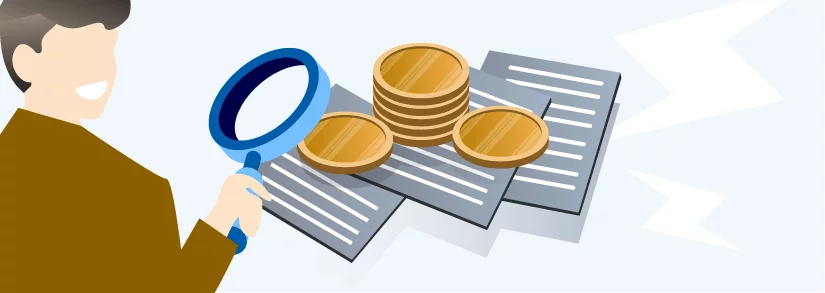Understanding Your Electricity Bill

Not sure what all those terms are on your bill? Use our glossary of billing terms to get straightforward and understandable definitions of common billing terminology.
Breakdown of Your Bill
Though your bill format will be different depending on the retailer, it will likely contain the following components:
Account Information
Here you will find important identifying information, including your name, service address, account number, and electricity service identifier (ESI ID#). Your account number and ESI ID# are unique to your account, so it is a good idea to check that they are correct on each bill so that you know that you are being billed correctly. You should also find your meter number on your bill. It is also a good idea to verify that the meter number listed on your bill matches your meter's number, so that you know that your consumption is being measured correctly. Find out how to read your meter.
Energy Information
Your bill should also include information about your energy usage, including the energy charge, your monthly consumption, and any applicable sales taxes.
The name of your contract or plan should also be indicated on your bill.
Billing Information
Your bill will also include the following items:
- Bill Number - use this number as a reference when contacting your REP if you have any questions about or problems with your bill
- Billing Summary - here you will find a summary of your payment history from the past month
- Amount Due - this amount will include any outstanding balances/credits from previous months
- Payment Due Date - this is the deadline for paying without being charged any late payment fees. If ever you think that you won't be able to pay your bill in full by the deadline, call your REP to discuss alternative payment options.
Looking for financial assistance to pay the utility bill?Find out which national and Texan Energy Assistance programs are available to help with your electricity bill, the eligibility requirements, and how to submit an application!
REP & Utility Contact Information
Here you will find ways to get in touch with your REP, including customer service and bill payment. Your bill will also include the name and emergency contact information for your local utility. While in general your REP is your first point of contact for most questions regarding your electricity, you must contact your utility directly in the event of a power outage.
Bill Glossary
Keep in mind that each Texas REP has a unique way of presenting billing information; some REP combine all of your taxes, power supply, transmission, and distribution charges into one number, whereas others may outline each item individually. Depending on your REP you may see some of or all of the following items.
Account Number
Your account number is a unique number that has been assigned to you by your REP. It identifies your account, and you will need to use it if you pay bills in person at a payment location, or over the phone.
Electricity Service Identifier (ESI ID#)
This number is assigned by your utility to identify the location of your meter. This is not the same as your account number. It is used by your utility as an "address" for your meter.
Another easy method to understand which TDU produces your electricity is to reference the ESI ID / ESID on the electric meter for your new address. This number is anywhere between 17 and 22 digits long, but all we need are five of those (digits 3 to 7) to know which utiltiy company the meter belongs to. The first two digits will be a ´´10´´ followed by the five digit TDU identity code. [For example: ´´10number86034669210]
| five digit number | Transmission & Distribution Utility company |
|---|---|
| 03109 | Sharyland Utilities (now Oncor) |
| 03278 | AEP TX Central |
| 07806 | Entergy (on MISO grid & Regulated) |
| 08901 | CenterPoint |
| 13830 | Nueces Electric Coop |
| 17008 | Sharyland Utilities-McAllen (now Oncor) |
| 17698 | SWEPCO (on SPP grid & Regulated) |
| 17699 | Oncor/SESCO |
| 20404 | AEP TX North |
| 40051 | Texas New Mexico Power (TNMP) |
| 44372 | Oncor Electric Delivery |
Meter Number
This is the number of your meter. You can find out how to read your meter (including where to find the meter number) in our guide. If your bill includes meter readings, you may see the following terms next to your usage:
- Actual: indicates that the usage amount was recorded and represents your actual usage
- Estimated: sometimes your utility is unable to perform a meter reading. In this case they will estimate your consumption for the month, based on your previous consumption history and/or the history for your home.
- Adjusted: the monthly usage determined after the estimation to determine that the estimated read was correct.
- Multiplier: your consumption is sometimes multiplied by a factor in order to determine the correct usage
Energy Charge
This is the price that you pay for your electricity supply, as was agreed to in your contract.
Base Charge
A base charge is a flat monthly fee that your REP may charge you regardless of how much electricity you consume. Not all REP charge base charges for all contracts, so make sure to check out whether a base charge is included in the price when you read the Electricity Facts Label
Minimum Usage Fee
Minimum Usage Fees are charged by some REP when you consume under a certain threshold monthly kWh consumption. If your contract includes a minimum usage fee, you may see this charge appear on your bill if you consume under the minimum required amount.
Note that the minimum usage fee may have another name, such as "base charge" or "monthly service fee".
TDU Delivery Charges
TDU stands for Transmission & Distribution Utility Charges. Your REP charges these charges on behalf of your utility, to cover the costs of delivering your power (operating and maintaining the grid, fixing power outages, etc) as well as the costs of metering. These fees are regulated by the PUC. TDU charges include:
Transmission System Charge
This charge covers the costs of transporting electricity over high voltage lines from the point of generation to the local distribution facilities.
TDU Delivery Charges
This charge represents the costs of delivering electricity from distribution facilities over the local poles and wires to your home.
Metering Charge
This is a charge to cover the costs associated with reading and maintaining customer meters.
Nuclear Decommissioning Fee
This charge recovers the costs of safely removing nuclear generating facilities from service.
Transition Charge
This charge covers the costs of transitioning from a regulated market to a competitive one. It is charged on a ¢/kWh basis.
Transmission Distribution Surcharges (TDU Surcharge)
These may include charges known as rate riders, and are generally temporary charges intended to recover unanticipated costs associated with transmission and distribution.
Transmission Cost Recovery Factor (TCRF)
This is a charge that recovers costs associated with updating the power transmission system.
Storm Recovery Charge
Your TDU charges this in order to cover the costs of repairing the power transmission & distribution system after storms. You also receive a Storm Recovery Tax Credit, which is from deferred federal income tax benefits associated with storm restoration costs.
Hurricane Cost Recovery Factor
As its title indicates, this charge recovers the costs associated with repairs after hurricanes
System Benefit Fund
This charge is set by the PUC in order to pay for energy efficiency and customer education programs.
Energy Efficiency Cost Recovery Factor
This charge is intended to cover the TDU's costs for energy efficiency programs.
PUC Assessment
This is charged by the PUC to recover some of the costs associated with administering its obligations under the Public Utility Regulatory Act.
| TDU | TDU monthly base fee | TDU ¢/kWh energy rate |
|---|---|---|
| AEP North | $3.57/mo | 3.0078¢/kWh |
| Oncor Electric Delivery | $3.42/mo | 3.4928¢/kWh |
| CenterPoint | $4.39/mo | 3.2669¢/kWh |
| AEP Central | $4.27/mo | 3.7458¢/kWh |
| TNMP | $7.85/mo | 4.0403¢/kWh |
Late Payment Fee
The maximum permitted late payment penalty permitted by the PUC is a one-time 5% charge.
Usage History
This is a graph that shows your historical usage patterns for up to one year.
Sales Tax
Most cities collect tax on the sale of electricity, but sales tax may also be collected by other authorized taxing authorities such as the state or special purpose districts.
Gross Receipts Tax (GRT)
This is a tax that the state of Texas imposes on REP who operate in towns/cities with populations larger than 1,000 people.
Miscellaneous Charges
These are charges that are not directly related to your power usage, such as deposits or charges for other services (such as a home warranty or other home services). These might also be called Recurring Charges or Non-Recurring Charges.
